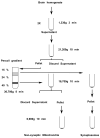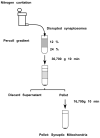Isolation of mitochondria from the CNS
- PMID: 20578034
- PMCID: PMC2908900
- DOI: 10.1002/0471142301.ns0722s52
Isolation of mitochondria from the CNS
Abstract
This unit contains a protocol describing the isolation of brain mitochondria by using discontinuous Percoll gradient centrifugation. The Percoll density gradient centrifugation separates synaptosomes, myelin, and free nonsynaptic mitochondria released from cells during tissue homogenization into individual fractions. Mitochondria entrapped in synaptosomes (synaptic mitochondria) can be liberated using nitrogen cavitation and then further purified by Percoll gradient centrifugation. These methods yield mitochondria that exhibit good respiratory coupling and high respiratory rates.
Figures



Similar articles
-
Rapid isolation of metabolically active mitochondria from rat brain and subregions using Percoll density gradient centrifugation.J Neurochem. 1990 Aug;55(2):698-707. doi: 10.1111/j.1471-4159.1990.tb04189.x. J Neurochem. 1990. PMID: 2164576
-
Isolation of mitochondria from rat brain using Percoll density gradient centrifugation.Nat Protoc. 2008;3(7):1228-39. doi: 10.1038/nprot.2008.105. Nat Protoc. 2008. PMID: 18600228
-
A rapid Percoll gradient procedure for isolation of synaptosomes directly from an S1 fraction: homogeneity and morphology of subcellular fractions.Brain Res. 1988 Feb 16;441(1-2):59-71. doi: 10.1016/0006-8993(88)91383-2. Brain Res. 1988. PMID: 2834006
-
Isolation and subfractionation of mitochondria from plants.Methods Cell Biol. 2007;80:65-90. doi: 10.1016/S0091-679X(06)80003-8. Methods Cell Biol. 2007. PMID: 17445689 Review. No abstract available.
-
Fractionation of cells and subcellular particles with Percoll.J Biochem Biophys Methods. 2000 Jul 10;44(1-2):1-30. doi: 10.1016/s0165-022x(00)00066-x. J Biochem Biophys Methods. 2000. PMID: 10889273 Review.
Cited by
-
Mitochondria Donation by Mesenchymal Stem Cells: Current Understanding and Mitochondria Transplantation Strategies.Front Cell Dev Biol. 2021 Apr 7;9:653322. doi: 10.3389/fcell.2021.653322. eCollection 2021. Front Cell Dev Biol. 2021. PMID: 33898449 Free PMC article. Review.
-
Percoll discontinuous density gradient centrifugation method for the fractionation of the subpopulations of Mycobacterium smegmatis and Mycobacterium tuberculosis from in vitro cultures.MethodsX. 2023 Aug 25;11:102344. doi: 10.1016/j.mex.2023.102344. eCollection 2023 Dec. MethodsX. 2023. PMID: 37711139 Free PMC article.
-
Metabolic Reprogramming in Astrocytes Distinguishes Region-Specific Neuronal Susceptibility in Huntington Mice.Cell Metab. 2019 Jun 4;29(6):1258-1273.e11. doi: 10.1016/j.cmet.2019.03.004. Epub 2019 Mar 28. Cell Metab. 2019. PMID: 30930170 Free PMC article.
-
Quantitative proteomics of synaptic and nonsynaptic mitochondria: insights for synaptic mitochondrial vulnerability.J Proteome Res. 2014 May 2;13(5):2620-36. doi: 10.1021/pr500295n. Epub 2014 Apr 22. J Proteome Res. 2014. PMID: 24708184 Free PMC article.
-
Dual role of mitochondria in producing melatonin and driving GPCR signaling to block cytochrome c release.Proc Natl Acad Sci U S A. 2017 Sep 19;114(38):E7997-E8006. doi: 10.1073/pnas.1705768114. Epub 2017 Sep 5. Proc Natl Acad Sci U S A. 2017. PMID: 28874589 Free PMC article.
References
-
- Beal MF. Mitochondria take center stage in aging and neurodegeneration. Ann Neurol. 2005;58:495–505. - PubMed
-
- Booth RF, Clark JB. A method for the rapid separation of soluble and particulate components of rat brain synaptosomes. FEBS Lett. 1979;107:387–392. - PubMed
-
- Brown MR, Sullivan PG, Dorenbos KA, Modafferi EA, Geddes JW, Steward O. Nitrogen disruption of synaptoneurosomes: an alternative method to isolate brain mitochondria. J Neurosci Methods. 2004;137:299–303. - PubMed
-
This paper describes the protocol that uses the nitrogen cavitation to isolate the whole mitochondrial population (non-synaptic and synaptic mitochondria) from brain homogenate.
-
- Brown MR, Sullivan PG, Geddes JW. Synaptic mitochondria are more susceptible to Ca2+overload than nonsynaptic mitochondria. J Biol Chem. 2006;281:11658–11668. - PubMed
MeSH terms
Substances
Grants and funding
LinkOut - more resources
Full Text Sources
Other Literature Sources

